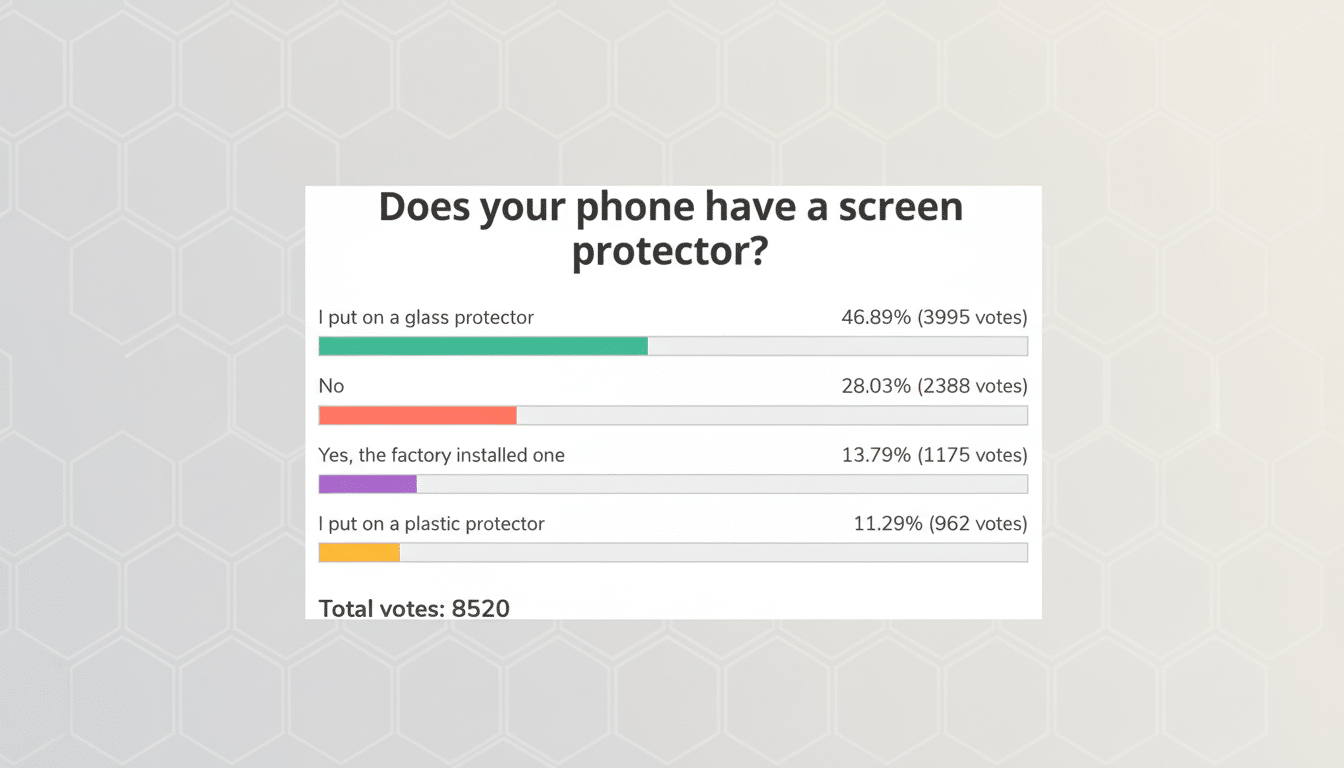Most smartphone owners aren’t taking chances, a new reader survey shows: just under 60% report using both a case and a screen protector on their device, while only a small percentage are leaving the gambling table with a naked phone.
In other words, if you’re still going bareback with your phone, the crowd thinks you’re asking for trouble.
- What the poll reveals about phone protection habits
- Why the majority sit on the sidelines of phone protection
- The case against cases and common user objections
- What experts recommend for practical phone protection
- The economics of peace of mind in phone protection
- Bottom line from the survey on phone protection habits

What the poll reveals about phone protection habits
The poll received a little more than 5,200 responses, which offered a clear picture of how people actually protect their phones each and every day. Almost 60 percent said they were going with a belt-and-suspenders combo of a protective case and a screen protector. Another 28.3% use a case, but go naked on the screen film. Just 4.6% use only a screen protector, and 7.8% have none at all.
That final number stands out in the last chart above, because it was larger than the protector-only group — so if you can get someone to compromise at all, they aren’t prioritizing scratch resistance as much as they are avoiding a shattered screen. It squares with the way phones normally go bad: cracked corners and powdery glass after a sudden impact, rather than slow-burn scratching at the hands of pocket debris.
Why the majority sit on the sidelines of phone protection
For many, the experience of repair is worth a lot. The cost of replacing or repairing a modern flagship is stupidly high. Official display repairs from leading manufacturers often fall in the $200–$400 range, and to replace an entire device can easily run four figures. Allstate Protection Plans has for years been following accidental damage, and its reports have consistently found that a majority of owners will drop their phones at some point — screens taking the hardest fall.
The direction in materials science is also light on bare screens. Corning’s new glass compositions focus on drop protection, not scratch resistance. Quartz — the stuff in beach sand — is rated as a 7 on the Mohs hardness scale, harder than most smartphone glass. A couple of grains in a pocket can scratch little grooves you’ll notice every time the sun strikes your display. And that resonates with the many poll remarks about “one beach day” or “keys in pocket” leading to months and even years of visible scratches.
The case against cases and common user objections
Yet, almost 1 in 10 are either averse to any protection or rely solely on a screen film. Their argument is the same, in every instance: cases add bulk and obscure premium design; protectors can hamper clarity, add haze, or impact in-display fingerprint sensors. If you splurged for polished titanium or curved glass, they say, why cover it up?

There’s some truth here. Poor-quality or incorrectly installed tempered glass may cause touch not to work. Matte films swap gloss for anti-glare and texture, which some people love and others hate. And bulky cases can interfere with the strength of magnetic accessories or wireless charging alignment if they aren’t compatible.
What experts recommend for practical phone protection
Repair pros usually hedge: pick protection that fits your risk and device. Some practical advice from techs and toughness testers:
- If you’re going to pick one, go case-first. A good case that has shock-absorbing corners and a raised lip will protect against the most catastrophic, expensive damage: corner and face-first drops.
- Use quality tempered glass on flat displays. Glass doesn’t resist scratches well and fares worse than average on direct impact, but tempered glass protects against most scuffs and is easy to replace. Opt for hydrogel or TPU on highly curved screens to avoid peeling and maintain touch.
- Be suspicious of the “9H hardness” claim. That rating is not from the Mohs scale, but from a pencil hardness test — and it doesn’t mean your screen has become unscratchable. Sand will still win.
- Install early. New phones with oleophobic coatings are perfect on day one — no dust for the install and better adhesion. Waiting will lure lint and micro-scratches under the film.
- Mind the camera. Today’s camera bumps are easy to hit. A case with a raised ring will protect lenses without the need for additional layers of glass that might interfere with image quality.
The economics of peace of mind in phone protection
Accessory manufacturers won’t object to these survey findings, but the math is in consumers’ favor as well. A quality $15–$40 case and a $10–$30 protector is nothing compared with a $300 repair or the resale-erasing wear of using the device scuffed up. Resale markets: “Excellent” is where a flawless screen is the make-or-break, and places like eBay, Amazon, or Swappa continually display higher prices.
Insurance providers echo the trend. Asurion and carrier plans issue millions of damage claims a year, and cracked screens are among the most typical. Sure, protection plans can save the day, but in many cases a dumb glass-and-metal sandwich is all that stands between your device and the repair counter — not to mention you and any number of nights with some loaner phone you’ll need to set up from scratch.
Bottom line from the survey on phone protection habits
The verdict is in: people multitask with a case and a screen protector; it’s not the exception — and their data tells the story. Phones don’t come cheap, glass is glass, and one wrong move can mean a long-lasting blemish. If you like the feel of a naked phone, that’s a fair choice — but most evidently believe it’s a risk they’re not willing to take.

